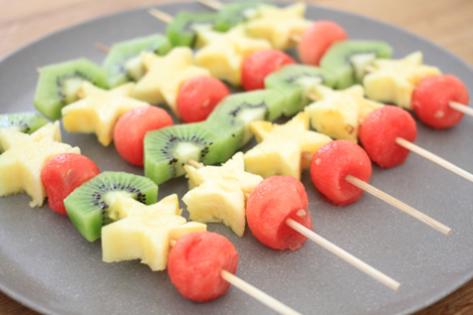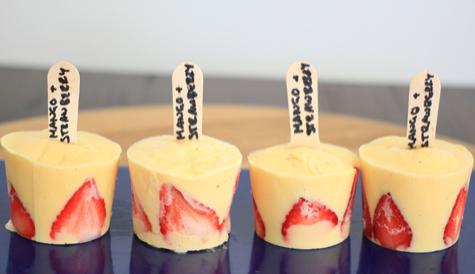Are you in the process of getting your kids ready to go back to school? No doubt the points on your ‘to-do list’ likely include books, bag, shoes, uniform …so what about healthy lunch box and after school snacks?
Kids require adequate fuel to get them through a busy and active day at school. They also require nutrients to optimise their growth and development. Snacks are a fantastic opportunity to help meet these requirements, but one of the most common questions I get asked is: “What makes a healthy snack?”
Foods coming from our core food groups almost always make a healthy snack. This includes fruit, vegetables, dairy, and grain foods and lean meats and alternatives. If these foods are presented in a minimally processed way, they are one step closer to a healthy snack.
I think one of the most important aspects to consider when organising healthy snacks for kids is to make them interesting and fun. Getting them involved in the preparation process and asking them what they like and what they think is healthy also helps ensure that they don’t swap or throw out their intended healthy snacks.
Lets take a look at how we can use our core food groups in an appealing way to minimise the number of packaged or processed snacks for kids. Not only will this help to improve your child’s health, but reduce your family’s carbon footprint.
1. Fruit and vegetables
Fruit and vegetable based snacks can provide fibre, water, phytochemicals and a range of vitamins and minerals. Snacks may include:
- Frozen fruit such as frozen berries mixed through natural yoghurt
- Small portions of dried apricots mixed with cubes of cheese or seeds such as sunflower or pumpkin seeds
- Tinned fruit in natural juices
- Savoury wholemeal flour or quinoa muffins with grated vegetables
- Corn fritters
- Fruit salad OR
- Veggie sticks with a nutritious dip such as hommous or tazziki – why not make your own?
2. Dairy foods
Dairy based snacks can help to provide protein, low glycemic index (GI) carbohydrates, calcium, vitamin D, B vitamins and zinc. Snacks may include:
- A container holding a mix of cherry bocconcini and cherry tomatoes
- Tubs of natural, Greek or flavoured yoghurt –freeze tubs of yoghurt (or small containers of yoghurt) before putting in your child’s lunch box to keep them cold
- Small portions of flavoured or plain milk (including soy milk) OR
- A slice of low fat cheddar cheese on wholegrain crisp breads.
3. Lean meats and alternatives
Lean meat and alterative based snacks provide protein, iron, zinc and B12. Snacks may include:
- Roasted chickpeas (a nice replacement for chips) – roast canned chickpeas with a sprinkle of paprika and cumin for about one hour on ~150 degrees (fan forced oven)
- Hard-boiled eggs
- Felafels
- Tinned bean mixes and fish OR
- Mini vegetable frittatas.
4. Grain foods
Grain foods will provide fibre, carbohydrate, B vitamins, zinc, vitamin E, magnesium, iron and phosphorus. Snacks may include:
- Wholemeal lavish bread with a nutritious dip such as beetroot
- Wholemeal savoury or fruit pikelets
- Homemade muesli clusters OR
- Dried cereal such as weetbix biscuits topped with cheese and a thin scrape of vegemite or peanut butter.
5. Choosing a healthy muesli bar
I often get asked about choosing healthy muesli bars, which can be a great convenient snack, especially for active kids.
My recommendations are to always try and choose the muesli bar that is highest in fibre, lowest in sodium and lowest in saturated fat per 100g. Most will have a little bit of added sugar to increase the palatability of the product without displacing key nutrients, however some bars marketed at children can have way too much sugar than required.
Unfortunately, reading sugar on the nutrition information panel is not always the best indication of a healthier option as the presence of natural sugars such as fruit or yoghurt will be listed under ‘sugars’ on the nutrition information panel. These natural sources of sugar are nutrient dense.
The ingredients list can help you identify added sugars. Look for sucrose, cane sugar, raw sugar, dextrose, glucose, honey, brown sugar, malt syrup, fructose, lactose, molasses, barley malt and caramel. If one of these ingredients is high on the list, this means that there is likely a large quantity of it in the product.
6. After school snacks
Feeding hungry kids after school can be challenging, especially when trying to find something that is fun, nutritious and easy to prepare. Try:
- Fruit skewers by using small cookie cutters to make different shapes (see picture below)
- Mini ‘pizzas’ with wholegrain English muffins topped with ‘no added salt’ tomato paste (or homemade tomato sauce), tomato, pineapple and cheese and placed under the grill
- Freezing any left over fruit to make smoothies – use frozen fruit such as as banana and strawberries and blend with yoghurt and milk
- Celery filled with your child’s favourite nut butter and a sprinkle of sultanas
- Baked bean filled toasties OR
- A platter filled with cubed cheddar cheese, sushi, rice crackers, lavish bread, dried fruit and a nutritious dip.
Get your kids to help you make the frozen yoghurt and fruit cups on the weekend (main picture and recipe below). They will be a great after school treat this summer.
Frozen fruit and yoghurt cups – mango and strawberry
Ingredients
- Fruit of 1 large mango
- 300g of Greek or vanilla yoghurt (my favourite is ChobaniTM fat free Greek yoghurt)
- 1 tablespoon of honey
- approximately 4 large strawberries, thinly sliced
- you will also need some (preferably reusable) plastic or paper cups and some paddle pop sticks
Method
1. Blend mango, yoghurt and honey until all ingredients have been blended to an even consistency.
2. Line the bottom and sides of the cup with the sliced strawberries (approximately one strawberry per cup).
3. Pour 100g of the mango/yoghurt mixture into each cup.
4. Place in the freezer until frozen (cover each with a piece of foil).
Tip
You can try any fruit and yoghurt blend! Next week I might try yoghurt, mashed banana and cinnamon.
Enjoy!









 Agree (0)
Agree (0) Disagree (
Disagree (











__small.png)










